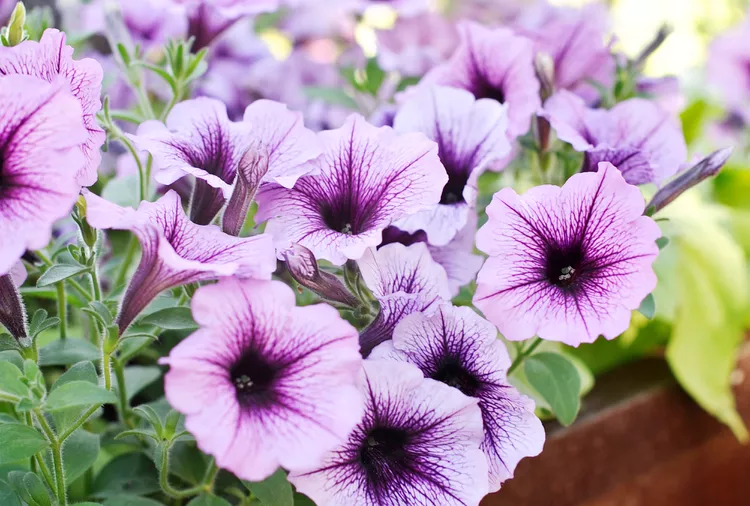Learning how to deadhead petunias is essential to keeping most varieties in full flower for as long as possible. Deadheading just means removing spent flowers. Don't worry—it's a snap.
A flower's job is to produce viable seeds to reproduce the plant. Once the flowers are pollinated, the plant shifts its resources to the next step of reproduction—seed formation, which requires a lot of energy. Interrupting the cycle by deadheading fading blooms prevents seed formation and forces the plant to start over with more blooms.
If you eventually want the petunia to self-seed for next year or you plan to save seeds, you must let some flowers progress through the process.
When to Deadhead Petunias
Petunias are ready to be deadheaded when faded or wilted flowers have lost their color and appeal. Since petunias bloom frequently, the task is easiest if approached often. Snipping or pinching off a few old flowers several times a week is much less daunting than waiting for the entire plant to be covered in them. Your petunia will look better and flower more with regular deadheading.
Some new petunia lines, like Supertunias and Wave petunias, are self-cleaning, meaning they don't need to be deadheaded. They're excellent choices for places that might be hard to reach, like hanging baskets.
Cutting back leggy petunias at the same time as deadheading encourages a more compact and full look. Most petunia varieties become leggy over time. The trailing stems grow longer with fewer blooms, giving the entire plant a scraggly appearance. By midsummer, it's usually time to cut back petunias by removing about a third of the foliage length. New blooms take a few days to arrive, but you'll have a much more attractive and vigorous plant for the rest of the summer.
Ways to Deadhead Petunias
Deadheading petunias doesn't have to be an intensive operation. Your thumb and forefinger can do the trick. Make sure to remove the entire flower where it attaches to the stem, not just the spent petals. You need to get the entire flower for no seeds to be made. Methods for deadheading petunias include:
- Thumb and finger: Below the base of the spent flower, hold the stem between your thumbnail and the pad of your index finger. Push your thumbnail through the stem with a pinch and remove the spent bloom entirely.
- Pruners, scissors, or snips: With snips, it's easier to remove the flower, base, and stem all at once. Follow the thin flower stalk down to the main branch and snip it there. Make sure to sanitize your tools before you begin to avoid spreading disease.
- Shears: Instead of removing individual blooms, use shears to remove a bunch at once. This method works well if you let the task go for a while, and the number of spent flowers now seems overwhelming. Give the plant a haircut by about a third. You'll remove some unopened blooms, but cutting the stems back encourages new branches of growth to develop, which will result in any more flowers.
Tips for Deadheading Petunias
While deadheading petunias is straightforward, there are a few key practices that will help keep your plants looking their best and flowering the entire season. If you accidentally remove an unopened bud, don't be too hard on yourself. The plant will replace it in short order.
- Deadhead often: Deadheading every day or two keeps the chore fast and easy and the plant blooming at its maximum.
- Remove the entire flower, including the base. Pulling off only the top part with the petals leaves behind the reproductive portion of the flower, and the plant can still make seeds and reduce blooming.
- Snip at the base of the stem for a clean look. You can cut just under the flower but that will leave little stems everywhere that can give the plant a messy appearance.
- Sanitize your tools before use to reduce the spread of disease with rubbing alcohol or a 10% bleach solution. You should also clean off your tools between plants.
- Check the plant for other issues while you're deadheading. Give it a quick once-over for any pests hiding under leaves, insect eggs, or foliage issues that may indicate a lack of nutrients.
How to Encourage More Blooms
For truly stunning petunias covered with color, you need to do more than deadhead the spent blooms. A healthy, content plant blooms to its maximum ability. A petunia that struggles due to a lack of water, sunlight, or nutrients won't have much energy to produce flowers.
- Provide full sun if possible. If your petunias receive only a few hours of sunlight daily, they'll grow slower and produce fewer flowers.
- Water when the soil feels dry to the touch. Stick your finger in and feel the soil or potting mix. If it feels dry, water deeply. For containers and hanging baskets, this might be daily. Petunias in garden beds can be watered less often, especially if they are mulched.
- Fertilize container petunias weekly or biweekly with a diluted general-purpose liquid fertilizer when watering. While the amount of soil in a container is small, the season is long. Petunias can quickly use up the available nutrients to fuel their profusion of flowers.




















